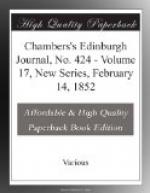THINNESS OF A SOAP-BUBBLE.
A soap-bubble as it floats in the light of the sun reflects to the eye an endless variety of the most gorgeous tints of colour. Newton shewed, that to each of these tints corresponds a certain thickness of the substance forming the bubble; in fact, he shewed, in general, that all transparent substances, when reduced to a certain degree of tenuity, would reflect these colours. Near the highest point of the bubble, just before it bursts, is always observed a spot which reflects no colour and appears black. Newton shewed that the thickness of the bubble at this black point was the 2,500,000th part of an inch! Now, as the bubble at this point possesses the properties of water as essentially as does the Atlantic Ocean, it follows that the ultimate molecules forming water must have less dimensions than this thickness.—Lardner’s Handbook.
ENGLISH PLOUGHING.
The following, written from England, is going the round of the papers, and is as true as the gospel, in my opinion. I have seen better ploughing here with a pair of oxen than in the old country with five horses; but Johnny won’t learn. ’Lord! only look at five great, elephant-looking beasts in one plough, with one great lummokin fellow to hold the handle, and another to carry the whip, and a boy to lead, whose boots have more iron on them than the horses’ hoofs have, all crawling as if going to a funeral! What sort of a way is that to do work? It makes me mad to look at ’em. If there is any airthly clumsy fashion of doin’ a thing, that’s the way they are always sure to git here. They’re a benighted, obstinate, bull-headed people the English, that’s the fact, and always was.’ Well done, Jonathan—quite true!—From a private Letter from Boston.
JOHN BUNYAN AND MINCE-PIES.
In No. 417 of this Journal it is chronicled that John Bunyan scrupled to eat mince-pies, because of the superstitious character popularly attached to them; but it would appear from an anecdote sent to us by a correspondent, that if this was true at all of the author of the Pilgrim’s Progress, he must have received new light upon the subject at a later period of life. When he was imprisoned for preaching—so says the anecdote—in Bedford jail, a superstitious lady, thinking to entrap him, sent a servant to request his acceptance of a Christmas pie; whereupon Banyan replied: ’Tell your mistress that I accept her present thankfully, for I have learned to distinguish between a mince-pie and superstition.’
FOREST-TEACHINGS.
There was travelling in the
wild-wood
Once, a child
of song;
And he marked the forest-monarchs
As he went along.
Here, the oak, broad-eaved
and spreading;
Here, the poplar
tall;
Here, the holly, forky-leaved;
Here, the yew, for the bereaved;
Here, the chestnut,
with its flowers, and its spine-bestudded ball.




